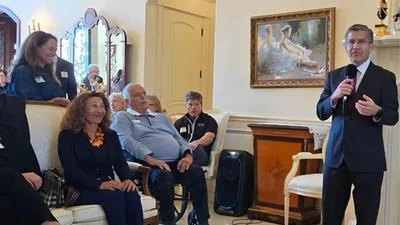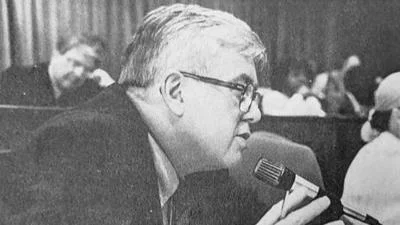Village of Bartlett Zoning Board of Appeals met Oct. 3.
Here is the minutes provided by the board:
M. Werden called the meeting to order at 7:10 pm.
Roll Call
Present: M. Werden, G. Koziol, B. Bucaro, J. Banno, G. Papa, M. Sarwas and C. Deveaux
Absent:
Also Present: Roberta Grill, Planning & Development Director and Renée Hanlon, Senior Planner
Approval of Minutes
A motion was made to approve the minutes of the September 5, 2019 meeting.
Motioned by: B. Bucaro
Seconded by: G. Koziol
Roll Call
Ayes: G. Koziol, B. Bucaro, J. Banno G. Papa and M. Werden
Nayes: None
Abstain: M. Sarwas and C. Deveaux
The motion carried.
Case (#19-02) Zoning Ordinance Chapter 4: Establishment of Zoning Districts and Chapter 9: Planned Unit Developments
Text and Map Amendments – Downtown Zoning Overlay (Form Based Code)
PUBLIC HEARING
The following Exhibits were presented: Exhibit A - Mail Affidavit
Exhibit B - Notification of Publication
R. Grill stated since the adoption of the Transit Oriented Development (TOD) Plan in 2016, Staff has implemented several key recommended strategies in downtown Bartlett. These include: the adoption of the Complete Streets Policy, the establishment of a 25 mph speed limit on downtown streets, a bike rack grant was awarded to the Village that will provide a bike shelter and additional bike racks in downtown around the Metra Station and, most recently, the Village received a grant for ADA improvements, which will include crosswalks to be incorporated in the downtown area.
To continue with the vision of the TOD Plan, the Village applied for and was once again, a recipient of an RTA Grant consisting of $20,000 (100% provided by the RTA) for the development and creation of a Downtown Zoning Overlay District. The goal of this new district would be to incorporate new walkable, connected, mixed-use developments that would establish a sense of place in the downtown area. This overlay district would amend the current Zoning Ordinance, via a text amendment, to create a downtown overlay with the existing underlying zoning designations remaining intact. The Zoning will not change on anyone’s property, just an overlay on the Zoning Map.
Unlike conventional zoning which focuses on the regulation of land uses, a Form-Based Code focuses on regulating the design and placement of the building as well as the street design. It specifically regulates items such as: the placement of buildings on a lot and along a street frontage, building scale, the relationship of buildings to one another, and the relationship between buildings and public spaces, including streets.
Leslie Oberholtzer of Codametrics was the consultant who was contracted by the RTA to draft the new code with input from a 12 member Steering Committee. This Committee included residents of the Village, the RTA, key area stakeholders, an elected official, George Koziol was the representative from the Zoning Board of Appeals and Village Staff. It met regularly for the past year to review and discuss the proposed TOD Zoning Overlay District regulations, to collaborate on key decisions and to ultimately review the interim draft document.
On June 10, 2019 an Open House was held to obtain public input on the draft document. Several business owners and residents attended. All were receptive of the document since the underlying zoning on each of their properties was not changing.
R. Grill stated consultant Leslie Oberholtzer with Codametrics will be joining this meeting by phone, with assistance from Michael Horsting with the RTA.
L. Oberholtzer stated R. Grill’s presentation was about the basics process before the Code was started. L. Oberholtzer stated that she wanted to skip ahead a little to explain or walk everyone through the draft of the Code.
L. Oberholtzer stated she used the TOD Plan as a guide for writing this Code. There isn’t anything that is new or unexpected in the overall goals. The Code is written in a way to result in very predictable development. The idea is, there will be less to negotiate between Staff, Developers and Village Officials as well as residents.
L. Oberholtzer stated the Code is organized as part of section 10-9. This chapter has been reorganized under the section Planned Unit Development and Planned Developments. Within the Overlay District, there are seven (7) sections.
1. Establishment of Overlay and Subareas
2. Administration and Exceptions
3. Building Regulations
4. Building Facades Design
5. General Site Design
6. Master Plan Sites
7. Definitions and Measuring
Establishment of Overlay and Subareas
Subarea 1: Downtown Core. The overlay is applied to the downtown area on top of the current zoning districts. This subarea does not apply to any single family or purely residential zoning districts. This area is around the train station, the tightest, most walkable building forms. This area will have ground floor retail and storefronts with upper story mixes of uses. This is very consistent with the current Town Center buildings.
Subarea 2: Downtown Edge. The downtown edge is intended to transition between the core and the residential neighborhoods adjacent to downtown, reflecting many characteristics of residential houses, such as pitched roofs and landscape yards, yet allowing for redevelopment at an appropriate scale.
Subarea 3: Downtown Residential. The downtown residential subarea is intended to allow a mix of residential buildings, including small apartment buildings, larger residential buildings, and townhouses.
Subarea 4: Commercial Corridor. The commercial corridor subarea is located adjacent to Devon Avenue and is intended to allow single use commercial, mixed-use, with residential or office buildings with both easy pedestrian and vehicular access.
L. Oberholtzer stated the Steering Committee met several times and gave great insight discussing the subareas. All of the images within the slide show are new construction images that may convey the type of development that may happen within the Downtown Core. These are not to be used as code they are just to be used as a representative of the subareas and to convey the type of building that would be expected.
Administration and Exceptions- this is the section of the code that staff already uses for an administrative site plan review process, with a few adjustments. Added is a Pre-Submittal Conference which is required with the Zoning Administrator for any development or redevelopment within the Downtown Overlay. The Zoning Administrator may require additional staff in attendance.
Planned Unit Developments are not permitted for new development within the downtown overlay. Existing approved planned unit developments and planned developments will continue to be enforced, unless the owner submits a new application.
Minor Design Exceptions from the regulations are defined and may be requested for approval by the Zoning Administrator during the site plan review process.
Major Design Exceptions to any of the overlay regulations may be approved through the Site Plan Review process that is already in effect. If a developer submits an application meeting most of the regulations but asks for major exceptions they will need to go through the Site Plan review process a major exception request before the ZBA for a hearing and approval process.
Building and Siting, this determines where the building is located on the site and where parking is located on the site. It is different for each of the subareas.
Façade requirements are unique in terms of how zoning is typically applied. This is meant to improve the pedestrian area within the downtown so each development relates to the sidewalk. Façade requirements include transparency window amounts, entrances and façade divisions into smaller increments for the pedestrian. Each subarea has different requirements for the amount of glass and roof types.
Cap types or roof types are specified to make buildings more aesthetically pleasing by using a pitched, parapet, flat type and a tower roof. The tower allows for an additional story with a limited footprint.
The Steering Committee had in depth discussion regarding the type of materials that would be acceptable. Brick, concrete masonry, fiber cement board, stone and wood are permitted.
Committee members have written a process of getting new materials approved when they come on the market by coming before the ZBA for use on specific buildings. Staff will determine if it should be added to the code.
Staff organized a table of parking requirements based on the kinds of parking requirements that Staff has been negotiating from past projects. There is also a series of parking credits to be an alternative solution to be submitted as a major design exception, again coming before the ZBA.
Major Site Plans, this is only relevant if there is a significant redevelopment or a large site that can be added on to. This will define block sizes consistent with the downtown. Breaking up large sites into smaller sites if they were to be redeveloped and providing open space within them. This will also allow for the subareas to be divided into smaller areas to have a variety of developments.
L. Oberholtzer asked if anyone had any questions or comments.
M. Werden thanked L. Oberholtzer for the presentation as well as the handout.
M. Werden asked Staff if they have received any calls on this. R. Grill stated, someone came into the Village, asked a few questions. They were told what the form based code was intended to and they seemed fine with it.
B. Bucaro asked if any developers had any comments or what they think of this. R. Grill when MoRE Brewing came in which was before this code is adopted, Staff told them what they were working on and showed them the code. They actually had major materials that were prohibited and they changed their plans to meet this code with using higher quality materials. If this code were adopted, they would now meet it. B. Bucaro wanted to know if developers thought the code would be too prescriptive that would box themselves into doing what they have to do as opposed to what they want to do. R. Grill asked L. Oberholtzer if she experienced any push back from developers regarding codes she has crafted from other towns. L. Oberholtzer stated no, this code was written to adhere to what is considered to be good development around the region. Developers are glad to have clear directions and only have to do their drawings once and submit them for approval. It’s an easier process for them when they understand what is expected upfront. L. Oberholtzer stated she has been doing this code for a while and if there was any pushback from developers, they were discussed and that’s where the Steering Committee comes in to decide what issues they get pushback from and which are valuable enough to retain in the code.
L. Oberholtzer stated she has an examples from another project in Brookfield. Developers wanted to work there specifically because they had this type of code and didn’t need to submit for a Plan Development. Also, L. Oberholtzer has worked on other projects that the RTA has supported. In Highwood she has done a project review for them based on a code that she had written. They have had multiple developments based upon the code and it was easier to review with the code than without one.
R. Grill stated she agreed with what L. Oberholtzer said. With the MoRE Brewing petition they had to ask for a variation request for the number of parking spaces. According to existing code they would have had to have 132 parking spaces, but with the Form Based Code that would need only 20. This Form Based Code would have eliminated some variations requests which developers are very happy about. Permits and the general process is much faster, they are in favor of this. G. Koziol stated with this code a developer will have a general idea of what is expected and will speed up the process. Or, a developer can make an appeal for a request if they wish.
M. Werden stated with MoRE Brewing he was shocked as to the amount of space they would be taking on the lot. Referring to the handout, “Up to 10 percent increase in total impervious coverage, not to exceed the total amount of permitted impervious plus semi-pervious coverage. (Compliance with storm water regulations is required.)” M. Werden stated they have addressed things such as this such as with CVS having to have storm water holding on site because it was a low lying area. R. Grill stated two additional pages that were handed out, show the impervious coverage has been omitted from the code. R. Grill stated the Village attorney added conditions and standards for the major exceptions if they come before the ZBA, to administer the ruling.
M. Werden opened the Public Hearing portion of the meeting. No one came forward.
M. Werden asked if there were any further discussions or motions. G. Koziol stated he would like to compliment L. Oberholtzer for the hard work that was done helping the Committee get to this level of document, high quality and what this will mean for the Village. M. Werden stated he agreed this will expedite the process. Years ago ZBA stated they would not have any objections if staff were to do minor approvals instead of making people come before the ZBA and have to wait for the hearing. This addresses a lot of that. G. Koziol stated he was impressed by the quality of the work that was done by L. Oberholtzer for the Village, this document could not have been done without her help.
C. Deveaux asked why glass block windows are prohibited since his 90 year old home has glass blocks. L. Oberholtzer stated glass block is a material that is not typical of the traditional building forms that are in the Bartlett area. They are often used on the front façade of buildings to let light in but what it does do is mask activities on either side of the glass blocks. It’s prohibited on the street façade of the building but can be used anywhere else on the building. It’s also for people on the street to know there is activity inside the building and for the visibility for people to look out to see what is going on the street as well. Visibility and Transparency is what keeps areas active and vibrant.
M. Werden asked if there were any further discussions or motions
G. Koziol made a motion to pass along a positive recommendation to the Village Board to approve case #19 - 02 Zoning Ordinance Chapter 4: Establishment of Zoning Districts and Chapter 9: Planned Unit Developments including the map amendments.
Motioned by: G. Koziol Seconded by: J. Banno
M. Werden closed the Public Hearing portion of the meeting.
Roll Call
Ayes: G. Papa, B. Bucaro, J. Banno, M. Werden, G. Koziol, M. Sarwas and C. Deveaux
Nayes: None
The motion carried.
R. Grill introduced Michael Horsting from the RTA which the Village received the grant from. M. Horsting stated it was their pleasure to work with the Village of Bartlett and had a great working partnership developing the downtown TOD Plan.
Old Business/ New Business
R. Grill stated we have new members on the ZBA, Charlie Deveaux and Michelle Sarwas, now we
have a full ZBA board. A contact list will be emailed.
R. Grill stated the Village Board has asked Staff to draft an Ordinance amending fence heights on major arterial streets to allow 6 foot fences without coming in for a variance request. This is still in the works.
M. Werden asked if there was a motion to adjourn.
Motioned by: G. Koziol
Seconded by: C. Deveaux
Motion passed by unanimous voice vote.
The meeting was adjourned at 7:55 P.M.
https://www.village.bartlett.il.us/Home/ShowDocument?id=10618






 Alerts Sign-up
Alerts Sign-up